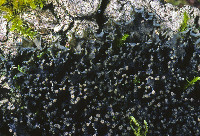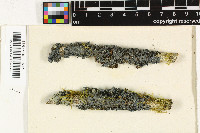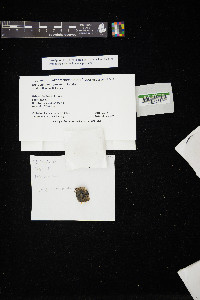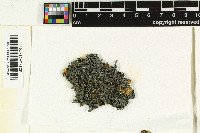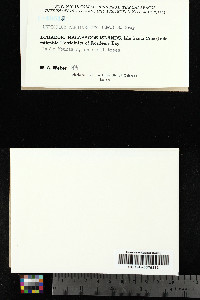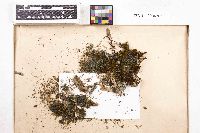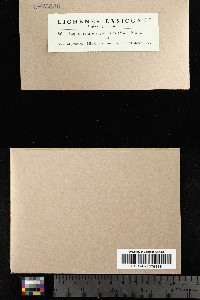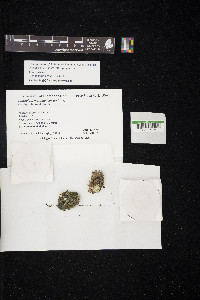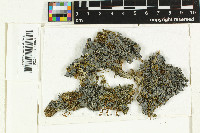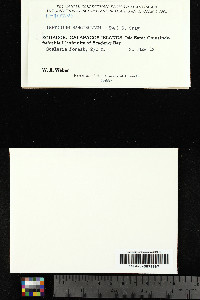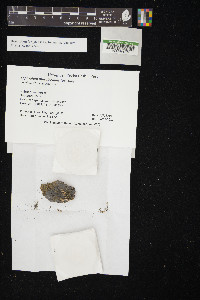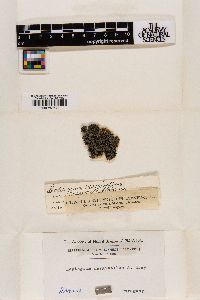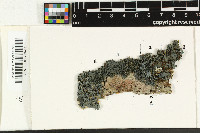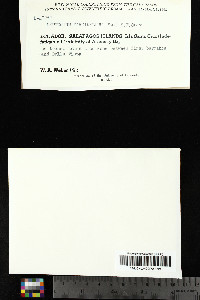
- Home
- Search
- Images
- Species Checklists
- US States: O-Z >
- US National Parks
- Central America
- South America
- US National Parks
- Southern Subpolar Region
|
|
|
|
Family: Collemataceae
[Collema marginellum (Sw.) Raeusch., moreLeptogium marginellum var. marginellum (Sw.) Gray, Lichen marginellus Sw., Parmelia marginella (Sw.) Ach.] |
Nat. Arr. Brit. Pl. 1: 401 (1821). Thallus dark gray to brownish gray when dry, olive brown when wet, foliose, loosely attached, moderately thin; outline irregular; lobes distinct, undulate, ± spreading; surface densely folded (plicate), dull; isidia numerous, granular to elongate phyllidiate, typically coronate-phyllidiate along the apothecial margin, rarely also in granular-coralloid clusters on the thallus surface; apothecia numerous, laminal, abundant across the thallus, sessile to distinctly stalked, globose; disk pale to deep reddish brown, urceolate, becoming concave to flattened; margin lecanorine, initially pale whitish or skin-colored, densely covered with blackish gray isidia (i.e., with a corona of several rows of granular to elongate phyllidiate isidia), with a broad paraplectenchymatous thalline exciple, a thin prosoplectenchymatous proper exciple, and a considerably thickened hymenium of mostly sterile paraphyses and few abortive asci; ascospores rarely developed, not seen (in Galapagos material). Substrate & Ecology: A very common epiphyte, also often on wood, plant debris, and occasionally even on soil (humus); throughout the moist uplands, in all humid vegetation zones, from the upper transition zone to the fern-sedge zone. Distribution: One of the most common species of Leptogium in the Galapagos; currently known from Floreana, Isabela, Santiago, Pinta, and Santa Cruz Island. Notes: With its coronate granular-phyllidiate apothecia it cannot be easily confused with any other Galapagos species. Specimens examined: Floreana Island: highlands above Cruz Farm, on bark, on Croton, 25 Apr 1976, Weber s.n. (QCA); Isabela Island: Cerca las fumarolas, Volcán Alcedo, 0, 27, 33.3, S, 91, 6, 43.2, W, 1034 m, Zona de pampa, bosque húmedo dominante gramíneas y árboles de Scalesia microcephala, on bark, Sobre Scalesia microcephala, 29 Sep 2006, Nugra 165, CDS no. 32819; Volcán Alcedo, outer SE-exposed slope, ca. 500 m below the crater rim, 0˚27’13”S, 91˚5’46”W, 1035 m, moist upland; disturbed by former grazing of goats; with Dennstaedtia cicutaria, Paspalum conjugatum and with scattered shrubs of Tournefortia rufo-sericea, on bark, twigs of Tournefortia rufo-sericea; semi-shaded, wind- and rain-sheltered, 6 Mar 2006, Bungartz 4121, CDS no. 28104. Pinta Island: along the trail up to the summit from the S-coast, 0˚34’39”N, 90˚45’7”W, 436 m, brown zone; dense forest of Zanthoxylum fagara, few Pisonia floribunda, and the vine Cissampelos pareira; Justicia galapagana in understory, on bark, base of Zanthoxylum fagara (ca. 10 cm in diam.), SE-exposed; sunny, wind- and rain-sheltered, 26 Feb 2007, Bungartz 5783, CDS no. 33456. Santa Cruz Island: abandoned farm along the northern part of the loop road from Bellavista to Garrapatero, 0˚40’58”S, 90˚18’31”W, 255 m, agricultural zone; overgrown farm area with introduced trees like Cedrela odorata, Persea americana, Syzygium malaccense, Cestrum auriculatum and others; small open clearing, on trunk of Cedrela odorata (ca. 40 cm. in diam.), S-exposed; shaded, win- and rain-sheltered, 19 Feb 2006, Bungartz 3683, CDS no. 27501; at base of barranco on old trail to Bella Vista, on Bursera, 11 Apr 1976, Weber s.n. CDS no. 10813; farm along the northern part of the loop road from Bellavista to Garrapatero (SCZ 37), 0˚40’56”S, 90˚18’40”W, 259 m, agricultural zone; living fence of thin Erythrina spp. (ø ca. 5 cm) around a farm, W-exposed, on bark, Erythrina velutina; sunny, wind- and rain exposed, 2/19/2006, Bungartz 3707, CDS no. 27565; Tras del Puntudo, ex finca de Don Benito, 0˚38’23”S, 90˚19’57”W, 732 m, Zona húmeda, on bark, Scalesia penduculata, altura al pecho, 28 Dec 2006, Nugra 247, CDS no. 33163; vicinity of Academy Bay, between first barranca and Bella Vista, transition zone, on trees, Weber 182 (L-40287), COLO no. 192394. Santiago Island: Cerro Gavilan, directly below the summit at the NE-exposed slope, 0˚12’19”S, 90˚47’6”W, 828 m, moist upland; formerly with scrub or forest, disturbed by former grazing therefore shrubs and trees missing; artificial pampa with Solanum americanum, Portulaca oleraceum, Senna occidentalis, Borreria laevis, and grasses, basalt boulders and outcrops, on rock, top of small basalt rock; sunny, wind- and rain-exposed, 22 Mar 2006, Bungartz 4713, CDS no. 28811. from: |
|
|
|

![Leptogium marginellum (Sw.) Gray [Bungartz, F. 8128 (CDS 40774)] Leptogium marginellum image](/imglib/lichens/CDS_Lichens/00040/CDS_40774_DX_2524_print_1555698804.jpg)

![Leptogium marginellum (Sw.) Gray [Bungartz, F. 4121 (CDS 28104)] Leptogium marginellum image](/imglib/lichens/CDS_Lichens/00028/CDS_28104_DX_0300_print_1555697634_tn.jpg)
![Leptogium marginellum (Sw.) Gray [Bungartz, F. 4728 (CDS 28839)] Leptogium marginellum image](/imglib/lichens/CDS_Lichens/00028/CDS_28839_DX_0781_print_1555697766_tn.jpg)



